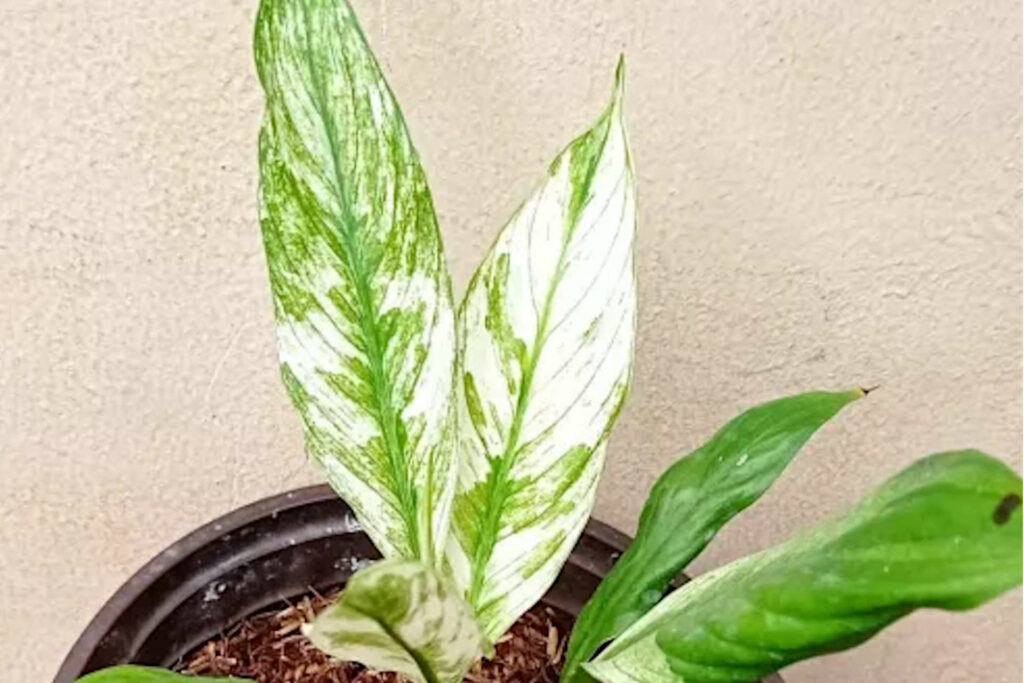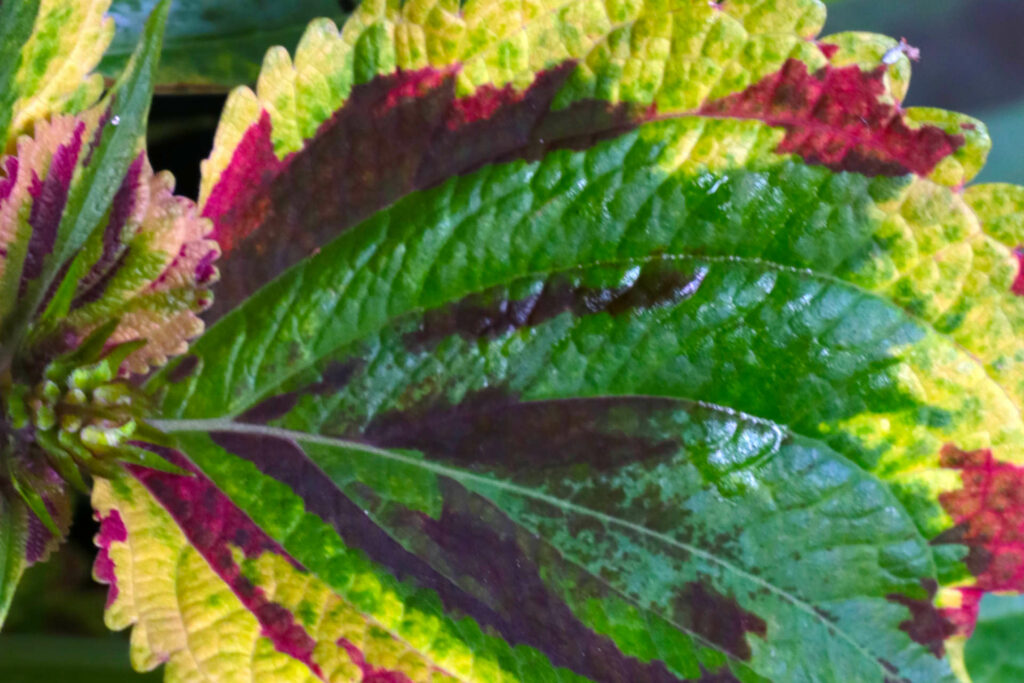Variegation in Plants – What Is It and What Causes It to Happen?
Kim is passionate about helping people create beautiful, healthy indoor spaces that are filled with plants. Kim believes that plants make us happier, healthier human...
- Variegation is a type of mutation that causes the leaves of a plant to have a different color on one part of the leaf than on another.
- Variegation is primarily caused by three different types of factors: environmental, genetic, and hormonal.
- Few plants with variegated foliage occur naturally in nature.
- Propagation of variegated plants requires that material preserves both types of plant tissue to be present.
- Common variegated plants include Monstera Plant, Peace Lilies, Philodendron, and Pothos plants...
The word variegation means a variety or pattern of colors. Variegation in plants usually refers to fascinating and beautiful forms of color variation or markings on foliage. It occurs when the shoots and leaves develop patches of different colors from the usual green. Several causes can trigger variegation patterns in plants. They can appear as a result of natural processes or through artificial induction.
These varying degrees of color/pattern on the plant's leaves make it appear beautiful in different types of settings and have become much sought after. Many of these mutations are random. However, some plants may be more prone to develop variegated forms than others, with some forms of variation in specific plants highly sought after.
Although many different species of plants can become variegated, few plants with variegated foliage occur naturally in nature. In truth, most are commercially grown, and the market for such plants, even at the lowest end, has become quite developed
What is Variegation

Variegation mutations cause the leaves of a plant to have a different color on one part of the leaf than on another section of the leaf. For example, variegated leaves may have different colors or patterns, such as light green and dark green stripes running along either side of their veins. Other common patterns include pink speckles throughout their entire surface area or white patches of varying sizes across different leaves.
Variegated foliage is a cultivator-driven phenomenon. It is commonly seen in genetically pure cultivars created in greenhouses. Unpurified populations of plants with variegated foliage are few and far between in nature.
Many gardeners desire variegated plants because they make interesting additions to any landscape design.
Causes of Variegation
Three different types of factors can cause variegation: environmental, genetic, and hormonal.
Environmental Factors
Environmentally-induced variegation occurs when a plant's environment causes a change in the pigment cells that produce chloroplasts or phytohormones. The result is that each cell has its own color and pattern (variegation). This can occur for many reasons, including:
- Not enough light reaching the plant's leaves - this causes yellowing leaves due to chlorophyll breakdown;
- Uneven light exposure which triggers chemical change caused by changes in light intensity and wavelength, and an increase in temperatures, during photosynthesis.
- Water loss during hot weather;
Chimerical variegation

Chimerical variegation occurs when two different kinds of genes mutate simultaneously, resulting in multiple genotypes growing side by side in the plant. This can be caused by a mutation that allows chlorophyll production and another that cannot. The irregular patches appear because only one gene allows for chlorophyll production while the other has none.
Vernal variegation occurs when veins are picked out in white or yellow on leaves or petals that were previously green before they developed their own set of colors.
Pigmentary Variegation
Pigmentary variegation is a common cause of variegation. It can occur in any plant with more than one color and is produced by masking the green pigment with other pigments. Often, it extends to the whole leaf, but in others, it can produce consistent zonal markings. The variegation can vary widely within a plant population; however, if you examine your plants closely enough and look at their leaves under different lighting conditions, you will see patterns emerge as well as some degree of consistency among individuals in terms of size and shape.
Pathological Variegation
There are a few types of variegation that can occur as a result of pathogenic causes.
- Pathologic variegation is the first type, which occurs when the plant is infected with a virus. Depending on what species you're growing, these viruses cause patterning on the leaf surface, which may be either dark green or light green in color. Some examples include:
- Mosaic viruses (also known as "banded mosaic") produce bands or stripes within an otherwise normal leaf due to their effect on pigmentation levels within leaves' cells. This can be seen most clearly during summer months when plants are most susceptible to infection from these types of viruses; however, any time there's heavy rainfall during fall or winter months could lead to an increased risk for spreading these types of diseases throughout your garden!
- Nutrient deficiency symptoms may also cause variable yellowing in specific zones within certain areas, such as midribs and near base margins, where there might not be enough nutrients being absorbed by these specific regions.
Defensive Masquerade as A Reason for Variegation
Variegation can also be a form of camouflage for a plant. It has been suggested that plants with variegated leaves are induced to produce certain patterns of leaf variegation, such as an obliquely-arranged appearance, as part of a defensive "masquerade strategy." In this, the leaf is less likely to appear as a vulnerable target to leaf miners, who do not discriminate between healthy and damaged tissue.
Propagating Variegated Plants
Propagating the plant must be by a vegetative method of propagation that preserves both types of plant tissue. These methods include:
- Stem cuttings
- Bud and stem grafting (budding is a process where the bud is planted in the ground while the top part of it develops into another plant)
- Division, separating at the roots
Fake/Temporary Variegation Using Chemical
Unscrupulous cultivators look to deceive buyers by producing fake or temporary variegation. There are several different methods by which this can be achieved. The most common is the use of a chemical called colchicine, which can be applied to plants to stop their chlorophyll from turning them green.
This causes it to look more like its original color and prevents variegation from happening again next year. However, if a mutation in the chloroplast genome occurs during this process, then once you remove all of that extra pigment, it will return as normal when your plant grows again!
Nomenclature of Variegated Plants

The Nomenclature of Variegated Plants is a Latin binomial system that indicates the species and cultivar. This means that if you see a plant with a non-italicized variegata tag, it means that it is not found in nature but rather has been bred through selective breeding techniques. On the other hand, italicized variegata indicates an actual species of plant.
Including this tag can be confusing because not all plants labeled as variegated have this tag; there are many hybrids with different colors on their leaves or petioles (the part of a leaf between its base and its edge). However, these hybrids are still considered variegated because they exhibit some degree of color change from one part to another across their entire surface area:
The Most Common Variegated Plants
The most common variety of plants that exhibit variegation are Foliage Varieties with high levels of chlorophyll and contain bright colors; these include Croton Plant with green leaves, Aglaonema Plant with red/pink leaves, Monstera Plant (also known as 'Fairy Lily') with green leaves, Peace Lilies, Philodendron, Pothos plants, Croton, Aglaonema and Snake Plant to name but a few.
Most Sought-After Variegated Plants
Variegated plants are the most sought-after plants in the world. They are also known as "paintings in plants."
They are very popular for their beauty and uniqueness. Variegation is a form of heterochromia, which means that there are two different colored pigments present at one time on each petal or floret (leaflet). The most common type of variegation is chimeral variegation, where different parts of a flower have different color tones. Rarely seen among wildflowers, it’s been cultivated extensively over time by humans who sought out these unusual blooms for decoration purposes around their homes or gardens!
Kim is passionate about helping people create beautiful, healthy indoor spaces that are filled with plants. Kim believes that plants make us happier, healthier human beings, and she loves sharing her knowledge with others so they can experience the joys of plant care for themselves. <a href="https://plantcaresimplified.com/kim-marson/">Read more</a>
More Posts